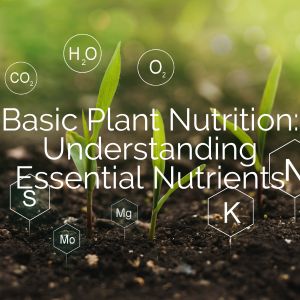Introduction
Understanding plant nutrition is key to fostering robust growth and productivity. Whether you’re a gardener, farmer, or plant enthusiast, recognizing the essential nutrients plants need and how they obtain them can significantly enhance plant health.
This article explores the vital macronutrients and micronutrients necessary for plant development, their sources, and strategies to maintain a balanced nutrient supply.
Essential Nutrients for Plants
Plants obtain their nutrients from the soil, water, and air. These nutrients are categorized into macronutrients and micronutrients based on the quantities required.
Macronutrients
Macronutrients are needed in larger amounts and are vital for plant growth and development. They include:
- Nitrogen (N): Essential for leaf and stem growth, nitrogen plays a key role in photosynthesis and protein formation.
- Phosphorus (P): Crucial for root development, flowering, and fruit production. It helps in energy transfer within the plant.
- Potassium (K): Supports overall plant health by regulating water uptake and improving disease resistance.
- Calcium (Ca): Strengthens cell walls, aiding in structural integrity and root health.
- Magnesium (Mg): A component of chlorophyll, magnesium is necessary for photosynthesis.
- Sulfur (S): Helps in protein synthesis and enzyme function.
Macronutrients serve as the primary building blocks for plant cells, providing the energy and structure needed for critical functions such as photosynthesis, cellular division, and stress resistance. Without an adequate supply, plants may exhibit stunted growth, reduced yield, and increased susceptibility to diseases.
Micronutrients
Although required in smaller amounts, micronutrients are equally important for plant health. These include:
- Iron (Fe): Vital for chlorophyll production and enzyme function.
- Manganese (Mn): Assists in photosynthesis and nitrogen metabolism.
- Zinc (Zn): Helps in hormone production and enzyme activation.
- Copper (Cu): Essential for reproductive growth and enzyme function.
- Boron (B): Supports cell wall formation and fruit/seed development.
- Molybdenum (Mo): Plays a role in nitrogen metabolism.
Micronutrients play a crucial role in enzyme activation, energy production, and plant metabolism. They contribute to key physiological processes, including the formation of strong cell walls, seed production, and the regulation of plant hormones. Deficiencies in micronutrients can lead to leaf discoloration, poor fruit development, and weakened plant structures.
Sources of Nutrients
Plants obtain nutrients primarily through the soil, but they can also be supplemented through fertilizers, compost, and foliar sprays.
- Organic matter: Decomposed plant and animal material enriches soil with nutrients and improves its structure.
- Fertilizers: Available in organic and synthetic forms, fertilizers provide specific nutrients to plants as needed.
- Water: Some nutrients, like calcium and magnesium, are absorbed through water sources.
- Air: Carbon dioxide (CO2) from the atmosphere is used during photosynthesis to produce energy.
Maintaining Nutrient Balance
To ensure optimal plant growth, maintaining a balanced nutrient supply is essential. Signs of nutrient deficiency or toxicity include yellowing leaves, stunted growth, or leaf deformities. Soil testing can help determine nutrient levels and guide appropriate fertilization.
Strategies for Maintaining Nutrient Balance
- Regular Soil Testing: Conduct soil tests at least once a year to determine nutrient levels and deficiencies. This allows growers to apply fertilizers and amendments based on precise needs.
- Use of Organic Matter: Incorporating compost, manure, or cover crops helps maintain soil fertility and improve nutrient availability.
- Appropriate Fertilization: Apply fertilizers in the correct proportions based on plant requirements and soil test results. Over-fertilization can lead to nutrient imbalances and environmental damage.
- Crop Rotation and Companion Planting: Rotating crops and using companion plants can help replenish soil nutrients naturally and reduce depletion of specific minerals.
- pH Management: Soil pH affects nutrient availability. Keeping soil pH within the optimal range (typically 6.0–7.0 for most plants) ensures efficient nutrient uptake.
- Irrigation Management: Overwatering can leach nutrients from the soil, while underwatering can limit nutrient absorption. Maintaining proper moisture levels helps sustain balanced nutrition.
By implementing these practices, growers can maintain a well-balanced nutrient supply, promoting plant health and maximizing growth potential.
Conclusion
Proper plant nutrition is absolutely fundamental for ensuring healthy growth and maximizing productivity. By gaining a thorough understanding of essential nutrients, their various sources, and how to maintain a balanced supply, plant caretakers can cultivate thriving plants that truly flourish in their environment.
A comprehensive approach to plant nutrition involves recognizing the role of both macronutrients and micronutrients. Macronutrients, such as nitrogen, phosphorus, and potassium, are required in larger quantities and are crucial for processes like photosynthesis and energy transfer. Micronutrients, including iron, manganese, and zinc, though needed in smaller amounts, are vital for enzyme function and hormone production.
Understanding the sources of these nutrients is equally important. Plants primarily obtain nutrients from the soil, but supplemental sources like fertilizers, compost, and foliar sprays can enhance nutrient availability. Regular soil testing helps identify nutrient deficiencies, allowing for targeted fertilization strategies that prevent over-fertilization and environmental harm.
Maintaining nutrient balance is key to preventing issues such as yellowing leaves or stunted growth. Techniques like crop rotation, companion planting, and pH management can naturally replenish soil nutrients and improve nutrient uptake. By implementing these practices, plant caretakers can ensure a sustainable and productive growing environment, ultimately leading to healthier and more resilient plants.
References
- Taiz, L., Zeiger, E., Møller, I. M., & Murphy, A. (2015). Plant Physiology and Development. Sinauer Associates.
- Marschner, H. (2012). Marschner’s Mineral Nutrition of Higher Plants. Academic Press.
- Brady, N. C., & Weil, R. R. (2016). The Nature and Properties of Soils. Pearson.
- United States Department of Agriculture (USDA) Natural Resources Conservation Service. Soil Health and Plant Nutrition.


